Selecting suitable luggage for air travel is an imperative aspect of pre-flight preparations. Owing to the vast range of choices, many flyers ponder – “Do airlines prefer hard or soft luggage?”
Each type has multiple pros and cons, and airlines may evaluate these to form their preference for luggage.
This piece will delve into the hard versus soft luggage argument and try to discern what airlines might lean towards.
Do Airlines Prefer Hard Or Soft Luggage? – Overview
Which type of suitcase do airlines pick?

Airlines don’t exhibit a preference for either hard or soft luggage, leaving the choice entirely up to the passenger.
Key factors to consider when choosing between hard-sided and soft-sided luggage include the airlines’ size and weight restrictions and the durability and versatility of the bag itself.
Hard-sided luggage, while heavier, provides superior protection for fragile items, making it a reliable choice for those carrying delicate belongings.
On the other hand, soft-sided luggage has the advantage of being lighter and more flexible, facilitating packing and enabling the bag to fit into tight overhead compartments.
Choosing between hard and soft-sided luggage ultimately depends on your needs and travel plans. Whether you value protection or flexibility, more will be the determining factor in your choice.
Regardless of your luggage type, knowing your airline’s specific size and weight limits is crucial to avoid any hitches during your journey. Choosing the right bag for your needs will ensure a pleasant trip. So, pack wisely and enjoy your travels!
What is the best type of luggage for the onboard plane?
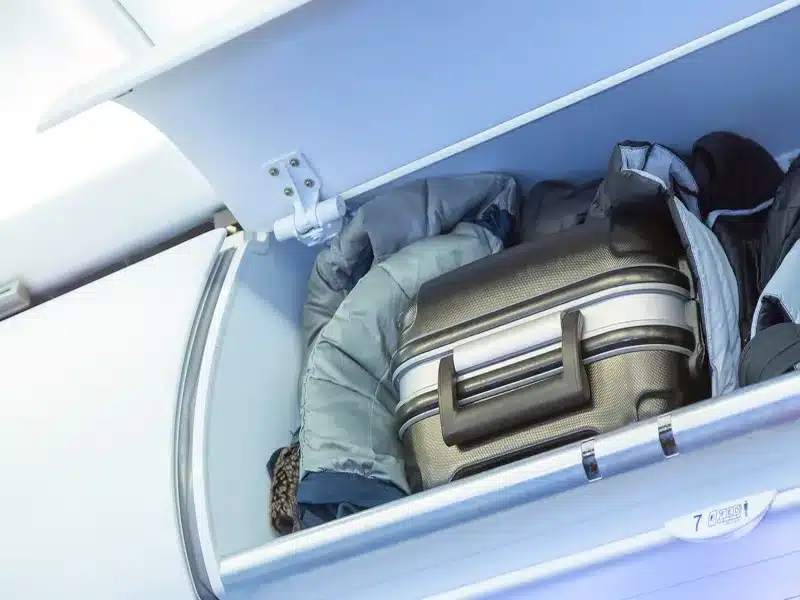
When it comes to air travel, choosing between hardshell and softshell suitcases often boils down to individual preference, as each type exhibits its strengths and weaknesses.
Constructed from tough materials, hardshell suitcases withstand the typical rough handling of air travel with little difficulty, offering superior protection for delicate items.
Softshell cases, meanwhile, bring flexibility to the table. They can expand to accommodate extra items and adapt to their contents’ shape.
Moreover, they often weigh less than their hardshell counterparts, an appealing trait for those aiming to limit checked baggage charges. However, the trade-off is that they may not safeguard contents as effectively.

As you select your suitcase, weigh considerations such as size, weight, and cost. This way, you can make a well-rounded decision that aligns with your unique needs.
Whether you lean towards the hard shell for its protective qualities or the soft shell for its lightness and flexibility, each suitcase type carries its considerations.
How Do My Bags Get Damaged?
Checking luggage can often be a daunting aspect of air travel; the uncertainty of whether your belongings will arrive at your destination intact can be discomforting.
This discomfort is sometimes not unfounded, as the quick turnaround times for flights, particularly for smaller aircraft such as 737s or 757s, necessitate quick and often rough luggage handling.
To meet flight schedules, ground crew members are often required to transfer luggage between the terminal and the aircraft quickly, a process colloquially referred to as “throwing bags.”
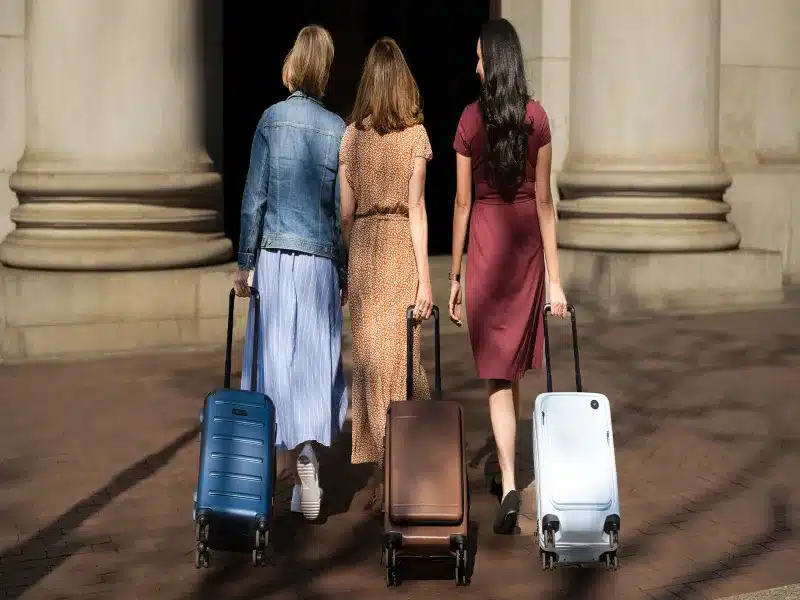
This involves loading the luggage onto a belt loader, which then transports the bags to a crew member inside the cargo hold. The crew member throws the luggage toward the back of the hold, where another member stacks the bags efficiently, reminiscent of a game of Tetris.
This method of luggage handling can cause damage to your belongings. The impact from the throwing can cause the wheels and handles of your luggage to break or crack, and the belt loader can snag and rip off loose straps.
Additionally, if your bag is particularly heavy, there’s a risk that the handles could break off due to the strain.
If you’re planning on packing fragile items, such as bottles of wine or alcohol, ensure that they’re packed securely to prevent breakage. One effective method is to place them in a special case with a handle inside your suitcase, which provides an extra layer of protection.

In contrast to smaller aircraft, larger planes such as 747s, 767s, 777s, and 787s use machines to load luggage. This involves placing the bags in a container, which the machine loads onto the plane.
This significantly reduces the chance of your luggage being damaged, as there’s no manual handling involved.
In terms of the best choice of luggage for air travel, hardshell luggage is generally the preferred option. The rigid exterior protects against the rough handling that can often occur during luggage transfer.
What Kind Of Suitcases Get Damaged The Most? The Least?
High-quality, sturdy luggage is paramount for a hassle-free travel experience, and the market is flooded with options. It’s essential to consider factors like durability and reliability when choosing your luggage.
Hard-sided suitcases are often recommended due to their robust and damage-resistant characteristics. A suitcase with an integrated handle can further prevent scratches and dings, enhancing its longevity.

A crucial aspect of long-lasting luggage is the presence of spinning wheels. They not only ease maneuverability but also save time during loading.
Another factor that can significantly minimize potential damage is luggage with compartments designed to withstand pressure changes, such as those placed in belly-side pockets.
For frequent travelers or those who carry heavy loads, backpack selection requires extra caution. It’s advisable to meticulously examine the suitcase’s details before deciding. A desirable trait is a robust design with sturdy wheels that ensure movement stability.
“Spinners,” suitcases with 4 wheels at the bottom, are the best choice for travel or work. Their user-friendly design reduces the need for frequent replacement due to loading damage.
Do Airlines Prefer Hard Or Soft Luggage? – Advantages And Disadvantages Of Luggage Types
Hard luggage
- Pros
Hard-side luggage is your go-to option if you travel with fragile items. Its sturdy exterior shell offers superior resistance to impacts and tears compared to soft-sided bags, making it the perfect choice when transporting delicate items, such as wine bottles or glassware.

Moreover, hardshell luggage often features built-in locks, enhancing the safety of valuable items. For those requiring an even higher level of security, aluminum luggage is worth considering.
This luggage type provides additional protection with its robust metal drawbolt latches, replacing the usual zippers. If security is a priority when packing fragile items, choosing hardshell luggage might be the answer.
- Cons
While offering robust protection, hardshell suitcases have limited flexibility, constraining what you can pack. Their rigidity hinders optimal use of space, unlike their softshell counterparts, which allow for a more efficient packing experience.
Hard luggage’s bulky form can be inconvenient for storage and transportation.

Unlike soft luggage, hard suitcases typically lack additional pockets and compartments. This might not pose a problem for those traveling with just a carry-on, but it complicates packing in larger suitcases.
The absence of compartments makes maintaining organization in your luggage challenging, increasing the likelihood of wrinkled and disarranged clothes and items during transit.
Soft luggage
- Pros
Soft-sided luggage is a travel essential that provides several benefits. One of its primary advantages is its flexibility, which allows it to fit into tight spaces. This feature makes it an ideal choice for those with confined storage space at home or in their cars.
Additionally, soft-sided suitcases surpass hardshell ones when it comes to organization. They often come with compartments in the lid and additional internal pockets that provide ample space for systematically arranging your items.
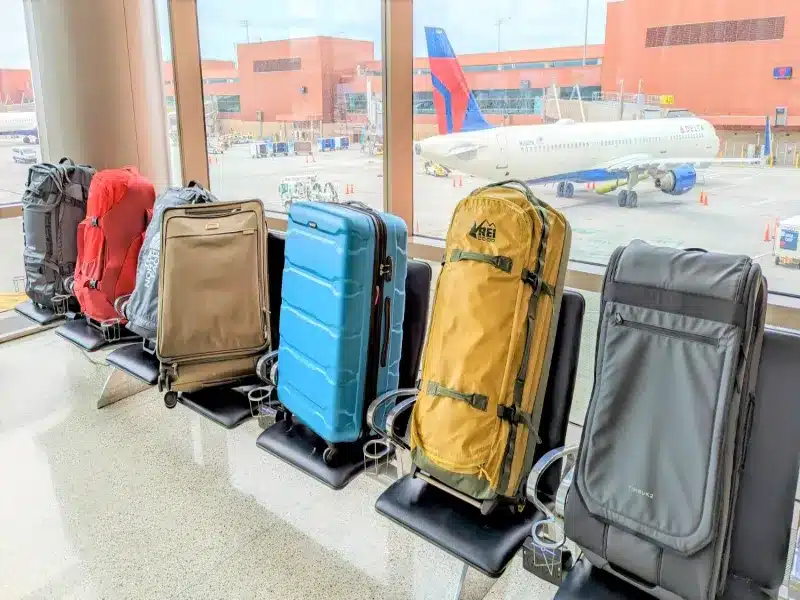
Another feature of soft-sided luggage is its expandability, allowing more items to be packed into smaller spaces.
Moreover, despite not being as rugged as hardshell cases, soft-sided luggage is known for its lightweight durability. This makes it the go-to choice for frequent travelers who need to safeguard their belongings while being mindful of weight restrictions and bulkiness.
- Cons
Softshell luggage, recognized for its lightweight and flexible structure, appeals to many travelers. However, its fabric material can absorb odors more easily than its hardshell counterparts, presenting a challenge for maintaining freshness.
The tendency for softshell luggage to hold the smell of potent items or encapsulate moisture can lead to an unwelcome surprise on future travels.
Managing these odors requires consistent care, with practices such as wipe-downs after each use and periodic professional dry cleaning recommended by luggage experts.
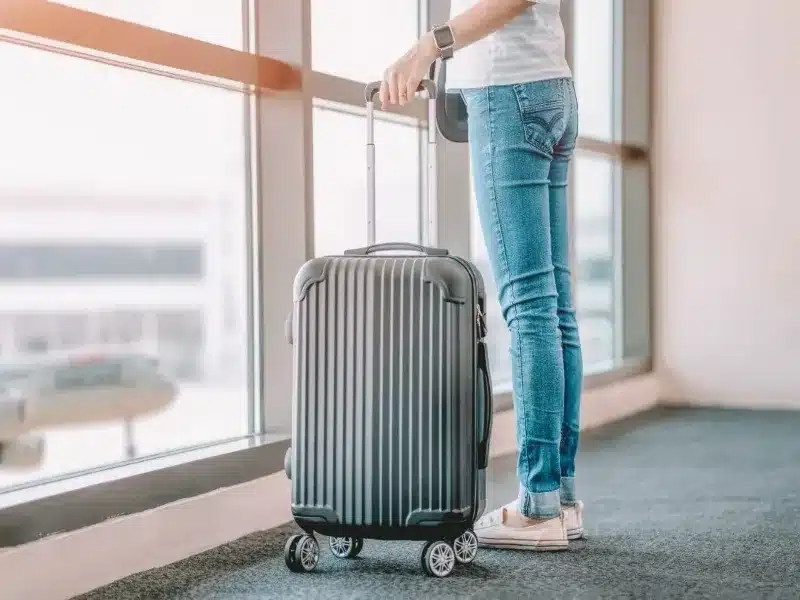
Softshell luggage can be more susceptible to damage, such as tearing and cutting, despite its flexibility. This is often due to travelers packing these bags more densely than hardshell suitcases, putting undue stress on the fabric and accelerating wear and tear.
To mitigate this, it’s advisable not to overfill your softshell suitcase and to select luggage crafted from sturdy fabric for increased durability. Taking these steps will help preserve the longevity of your softshell luggage.
Furthermore, using interior liners or travel bags to protect fragile belongings is a good idea. This can protect against any punctures caused by protruding items in the suitcase, which may lead to rips and tears in the fabric.

Additionally, using organizational compartments within the suitcase is another simple way to keep items from shifting during transit.
In conclusion, while softshell luggage offers more flexibility than hardshell suitcases, it’s important to take necessary precautions to maintain quality and prevent odors or damage.
Regular maintenance, such as wipe-downs and careful packing practices, allow you to enjoy your softshell luggage for many future trips.
How To Protect Luggage?
Do Suitcases Need To Be Cleaned?

Indeed, it’s imperative to clean your travel luggage. As you journey through various locations, your suitcases encounter shared environments and can become hosts to germs or bacteria.
Decrease your risk of contamination by meticulously disinfecting your luggage before handling it. Post-cleaning, remember to wash your hands or consider using gloves for an extra layer of protection.
These actions help prevent the spread of potentially harmful organisms and their subsequent introduction into your home. In summary, an added cleaning step for your suitcase becomes a non-negotiable part of your travel routine.
How Do I Protect My Soft Luggage?
Soft-sided luggage, though susceptible to scratches and other forms of damage, can be well protected with a few simple measures.
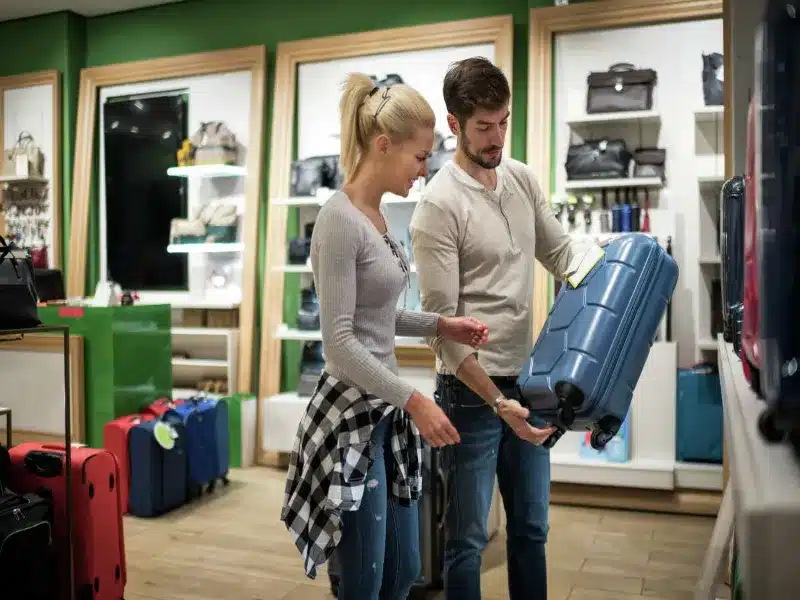
Instead of resorting to hardshell suitcases or wrap protections, let’s delve into more straightforward solutions that ensure the safety of your soft luggage during travels.
Firstly, overstuffing is a primary culprit behind the wear and tear of soft luggage. It’s crucial not to overload your bag and to manage the space within it mindfully. Packing cubes can be a great asset in this scenario, helping to optimize available space without putting undue stress on the bag’s fabric.
Secondly, metal zipper pulls on your bag can cause snags and damage the surrounding material. Fabric guards are an effective solution, covering zipper pulls and providing additional protection.

One cost-effective and simple protection method is using a cover for your baggage. Seek out covers that balance lightness and durability, ensuring they can endure the journey without adding significant weight to your luggage.
Lastly, how one handles soft-sided luggage can significantly impact its longevity. Overhead compartments in planes or trains often house these bags, demanding careful handling. Avoid surface dragging and lift your bag correctly to prevent internal or external damage.
In conclusion, with these measures in place, your soft-sided luggage can brave through many travels without losing its charm.
What Cleaner Should I Use On Hard-Sided Luggage?

Hard-side luggage can be effectively cleaned using a mild soap solution. Apply this with a soft cloth or sponge, ensuring a thorough clean.
To avoid leaving soap marks, rinse with plain water after cleaning. An alternative cleaning method could be using a spray cleaner tailored for hard-side luggage.
After applying the product, wipe it off with a dry cloth, followed by a damp cloth, to clear any leftover residue. Ensure the luggage is completely dry before storing it.
Before applying any cleaning solution, performing a patch test is advisable. This can help prevent potential scratching or other damage to the exterior of your luggage.
If the patch test is successful, use the chosen cleaning solution for the rest of your luggage. Choices between hard-side and soft luggage often come down to personal preference, but always consider airline preferences and restrictions.
What Cleaner Should I Use On Soft-Sided Luggage?
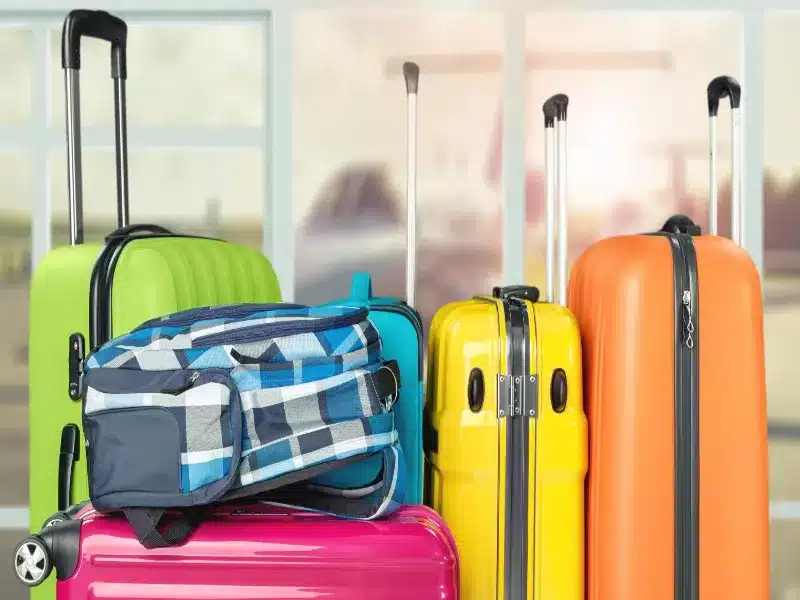
Maintaining soft-sided luggage requires a careful cleaning approach to prevent damage or discoloration. A solution of mild soap and water is the best choice.
If your luggage has persistent stains or dirt accumulation, gentle brushing can effectively remove these particles. Once the cleaning process is complete, rinse the bag with clean water and allow it to air dry before storing it.
Following these easy steps will prolong the suitcase’s lifespan, keeping it in prime condition for the future.
Therefore, remember to ensure your luggage is clean and well-maintained when planning your next journey!
In which situations do we choose soft and hard luggage?
Here’s our summary table for situations in which soft or hard luggage might be suitable:
| Situation | Soft Luggage | Hard Luggage |
| Air Travel (Checked Luggage) | No, unless your luggage is made of high-end material and has strong locks and zippers. | Yes, your luggage can protect valuable or delicate items for durability. |
| Car Travel | Yes, your bags are more flexible and fit better in the back seat or trunk. | Yes, you can protect fragile items and prevent breaks and damage from shifting during moving. |
| Adventure Travel (for example Hiking, Camping) | Yes, because the soft side bag is easy to carry around and store in narrow spaces. | No, the hard-side luggage is less durable and might not protect items against rough handling. |
| Business Travel | Yes, soft bags are suitable for short trips and easily fit in overhead compartments. | No, unless you have valuable or fragile items which need extra protection. |
| Luxury Travel (for example Resorts, Cruises) | Soft-side luggage might not look as luxurious and elegant as hard-side luggage. | Yes, for durability and to keep expensive and delicate items such as jewelry and electronics. |
| Relocating or Moving | No, soft luggage is less durable and might not protect items against rough handling. | Yes, for long-lasting use and to protect valuable or fragile items. |
| Sports Travel (for example Skiing, Golfing, Snowboarding) | Yes, soft bags are easy to store and carry your equipment. | No, hard luggage might not provide enough protection for fragile or expensive equipment. |
Do Airlines Prefer Hard Or Soft Luggage? – FAQs

Do Hard Luggage Break Easily?
When pondering whether airlines prefer hard or soft luggage, the truth is that it varies. Hard suitcases, typically crafted of robust materials like aluminum or polypropylene, often exhibit greater resilience than their softer counterparts, such as those made from ABS or polycarbonate.
Despite the inherent strength of these materials, they are not impervious to extreme force or pressure, and issues may arise with poor-quality zippers or frail hinges on hard suitcases.
Generally, hard suitcases afford enhanced protection from external damage compared to soft-sided options.
They are not exempt from wear and tear from mishandling or rigorous handling during transit. Though there are no guarantees against damage, a well-chosen, properly cared-for hard suitcase will likely outlast a soft-sided one.
In short, opt for a high-quality hard suitcase that fits your requirements and handles it with due care.
Is Hardside Suitcase More Durable Than Fabric Luggage?

The durability of luggage often comes under scrutiny, and most people find hard-side luggage more resilient than its fabric counterpart.
Hardside suitcases, typically constructed from polypropylene, aluminum, or polycarbonate materials, are strenuous and can resist impacts, making them well-suited for rough handling during transit.
An added advantage of these suitcases is their hard shell, offering an extra protective layer for the contents inside.
On the other hand, fabric luggage, while not as robust as hard-side bags, does offer some unique benefits. They are generally lighter, providing ease of mobility, and are often more economical.
Additionally, they are available in many patterns and colors, allowing travelers to showcase their style.
However, fabric luggage can pose a few disadvantages. They are more prone to tears and punctures and easily attract dirt. Moreover, they are susceptible to water damage and are more likely to absorb odors, unlike the hard side luggage.
What Is The Largest Size Of Luggages For Check-In International?

When planning an international trip, it is crucial to know the luggage size restrictions set by airlines for checked-in bags.
Most adhere to a standard size cap of 62 inches or 157 cm, which is the total measurement of the bag’s height, width, and length.
For weight, the standard limit is usually set at 50 pounds or 23 kg for checked luggage.
However, it’s important to remember that these restrictions may vary between domestic and international flights and among different airlines.
To avoid any last-minute hassle, it’s recommended to check the specific baggage policies of the airline you’re flying with before making your booking. Some airlines might have stricter rules for certain airports or countries.
In short, it’s always better to ensure that your luggage meets the airline’s rules to avoid unforeseen issues while boarding.
How To Measure Linear Inches Of A Suitcase? (Height + Width + Depth)

Calculating the linear inches of your luggage can be accomplished easily with the help of a ruler or a tape measure. Follow these simplified steps for a precise measurement:
- Position your suitcase on a level surface, ensuring the wheels are upwards.
- The height of the suitcase should be gauged from the base of the wheels or the surface to the top of the handle or the loftiest point that remains rigid when pressed down. This measurement should be taken straight up, not at an angle.
- Assess the breadth of your bag by measuring from the left to the right at its broadest section.
- Finally, estimate the depth by measuring from the front to the back at the deepest segment.
After taking all 3 measurements, sum them up to acquire your linear inches measurement. For instance, if the dimensions of your suitcase are 21 inches in length, 14 inches in width, and 8 inches in depth, the total linear inches equates to 43 inches.
Conclusion
In conclusion, the question “Do airlines prefer hard or soft luggage?” often arises among frequent travelers.
While airlines have no definitive preference, hard-sided suitcases are generally considered superior. They offer better protection against the rigors of travel, including pressure changes in the airplane’s cargo hold.
Furthermore, built-in handles and spinner wheels add to their durability and ease of use. However, irrespective of whether you choose hard or soft luggage, the emphasis should be on quality, durability, and practicality to withstand the demands of frequent travel.